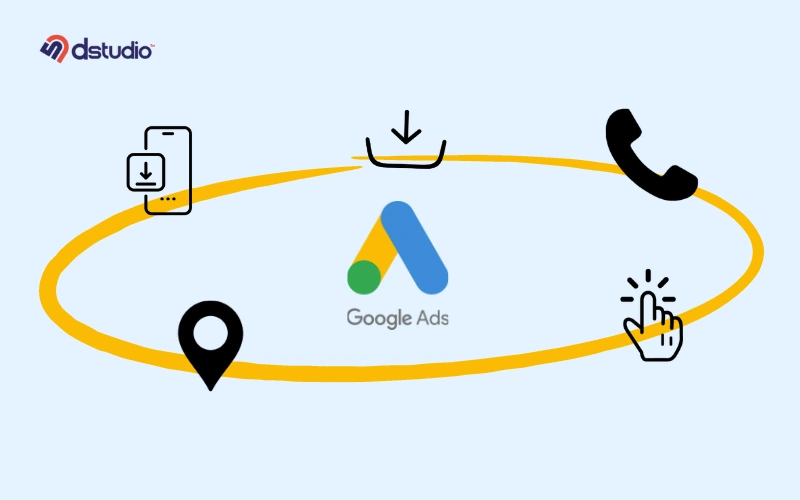SEO can be a tricky field to navigate. It can feel like trying to hit a moving target as new algorithms and best practices pop up frequently. But there’s good news!
A new approach called Generative Engine Optimization (GEO) is here to simplify things. Imagine search engines that can anticipate a user’s intent and deliver the perfect results. GEO acts as a high-tech upgrade to traditional SEO. This approach uses artificial intelligence to understand user intent and craft better content.
Want to master SEO with GEO? Buckle up! We’ll take you through the basics, explain why it’s the next big thing, and offer practical steps to put it to work for you.
The Progression of Search: from SEO to SGE to GEO
GEO is a recent idea that comes from the connection between digital content and search engines. To really understand GEO, we must look into how things have been changing.
SEO
SEO stands for Search Engine Optimization. SEO focuses on optimizing website content for specific keywords to rank higher in SERPs.
Website owners use techniques like keyword research, on-page optimization, and backlink building as their SEO strategies to improve visibility in relevant searches.
SGE
SGE stands for search generative experience. SGE utilizes AI to understand user intent and generate summaries of information from multiple sources.
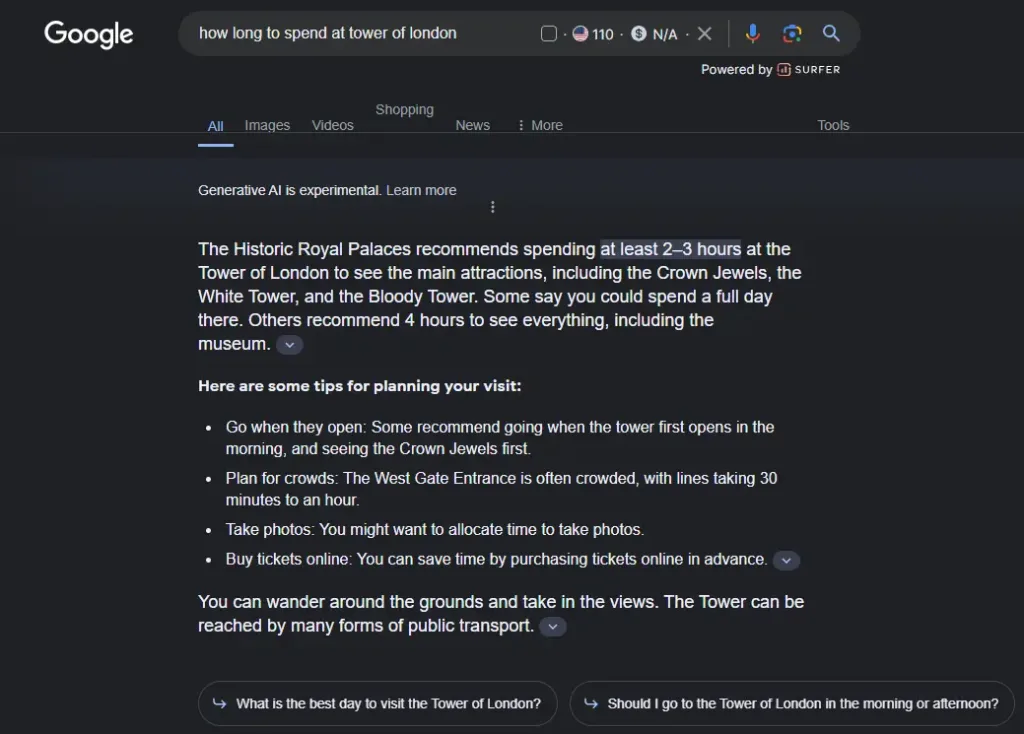
SGE responses are more comprehensive and informative, aiming to answer a user’s query directly, rather than just providing links.
GEO
Generative Engine Optimization (GEO) is a new concept compared to the well-established Search Engine Optimization (SEO) we all know.
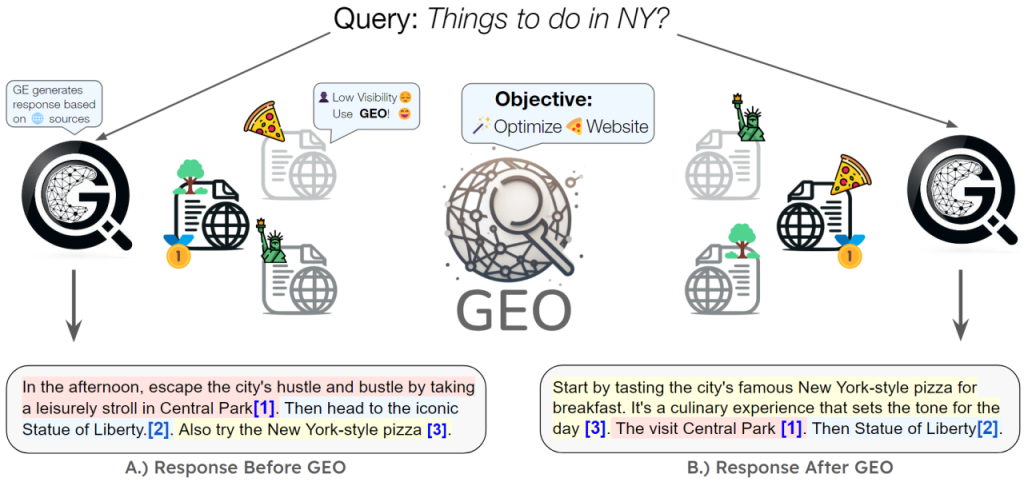
Image Source: Research Paper
Generative engines use AI to analyze information from various sources and synthesize a comprehensive answer directly on the search engine results page (SERP).

Image Source : Research Paper
SEO to SGE: From Ranking to Understanding Users
The shift from SEO to SGE isn’t just about algorithms; it’s about a smarter search experience. SEO focused on getting websites to the top of results pages, often through keyword manipulation.
SGE, powered by AI, prioritizes understanding user intent. Instead of just showing links, SGEs aim to directly answer queries with informative summaries, focusing on user interaction and satisfaction.
SGE to GEO: Optimizing for AI-powered Search
Website owners face a new challenge with the rise of google’s Search Generative Experience. In response, GEO steps up to tackle this challenge.
GEO brings new optimization techniques to optimize content beyond keywords. It highlights the significance of arranging content effectively, making it reliable and appealing to AI. This ensures that websites can be noticed and included in SGE summaries in an effective manner.
| Aspect | SEO | SGE | GEO |
| Definition | It’s the practice of improving your website to show up higher in search results. | SGE is a next-level search engine that uses AI to understand user intent and provide answers directly. | GEO is optimizing content for AI-powered search engines (SGEs) to be included in their informative summaries. |
| Goal | Increase website visibility in search results. | Provide comprehensive answers to user queries. | Improve content visibility in SGE summaries. |
| Key Techniques | Keyword research, on-page optimization, backlinks | Understanding user intent, AI-powered information retrieval | Content structure, citations, clear writing |
| Focus Area | Keyword ranking | improving user interaction with AI driven results | making content more compatible for AI search |
| Outcome | Higher website traffic | Improved user experience | Increased content visibility in AI-powered search engine (SGE) summaries |
| Metrics | Organic search ranking position | Click-through rate (CTR), user engagement metrics | SGE result position, content featured in summaries |
What Is Generative Engine Optimization (GEO) and How Does It Work?
(This article is inspired by a research paper on GEO )
Generative search engines are a big advancement in search engines. Unlike regular search engines that just give a list of websites, generative engines can make their own responses using information from different sources.
Overview of Generative Engine Optimization (GEO):
Concept: GEO means making online content better for search engines that use generative AI technology. This could mean understanding how generative AI models look at and choose content, and then changing content to fit those standards.
Applications: This includes making content easier for AI to understand and use, organizing content so generative models can prioritize it, or making content that answers questions directly so it’s more likely to be chosen by AI-generated results.
Focus: GEO is for people who make and promote content and want it to do well in search results, especially now that search engines use AI to make responses.
The recent successes of large language models (LLMs) have resulted in the creation of better systems like BingChat and Google’s SGE.
These systems, known as generative engines (GE), bring together the strengths of regular search engines with the flexibility of generative models. They don’t just find information, but also generate responses using various sources.
Your Search Transforms into a Conversation :
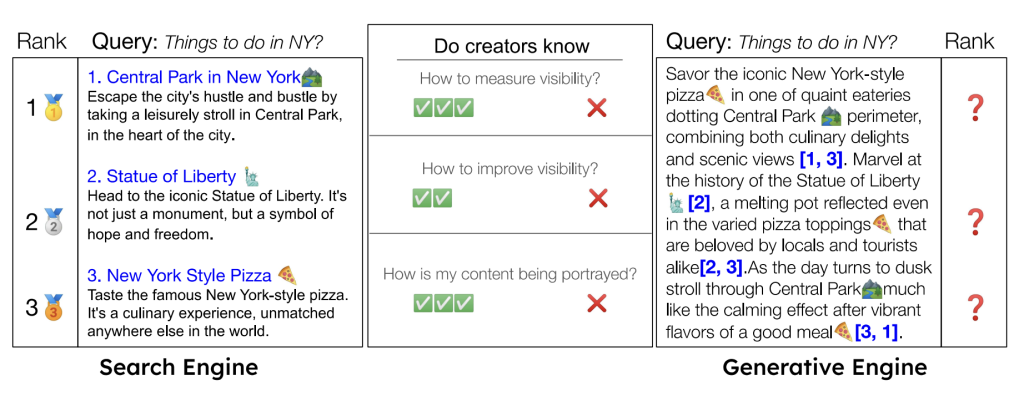
Image Source : Research Paper
If you look at the picture above, you’ll see two different search results.
On the left side is a traditional search engine, where you would get a list of links when searching for “things to do in New York”. The top three results were (1) Central Park, (2) The Statue of Liberty, (3) New York style pizza. This is what we’re used to seeing.
However, things have changed a bit with the new generative engine. Now, the results are more personalized and helpful. Instead of just a list of links, it gives you suggestions and recommendations.
For example, it might say, “Hey, here are all the things you can do in New York! Check out this pizza place, or you could go visit Central Park, or whatever.”
Optimizing for Gemini & ChatGPT
The rise of large language models like ChatGPT and Gemini has brought about a new era of search engines.
To improve your online visibility, it’s important to optimize your content for ChatGPT and Bard. This means making your content more persuasive, authoritative, and packed with relevant keywords and statistics.
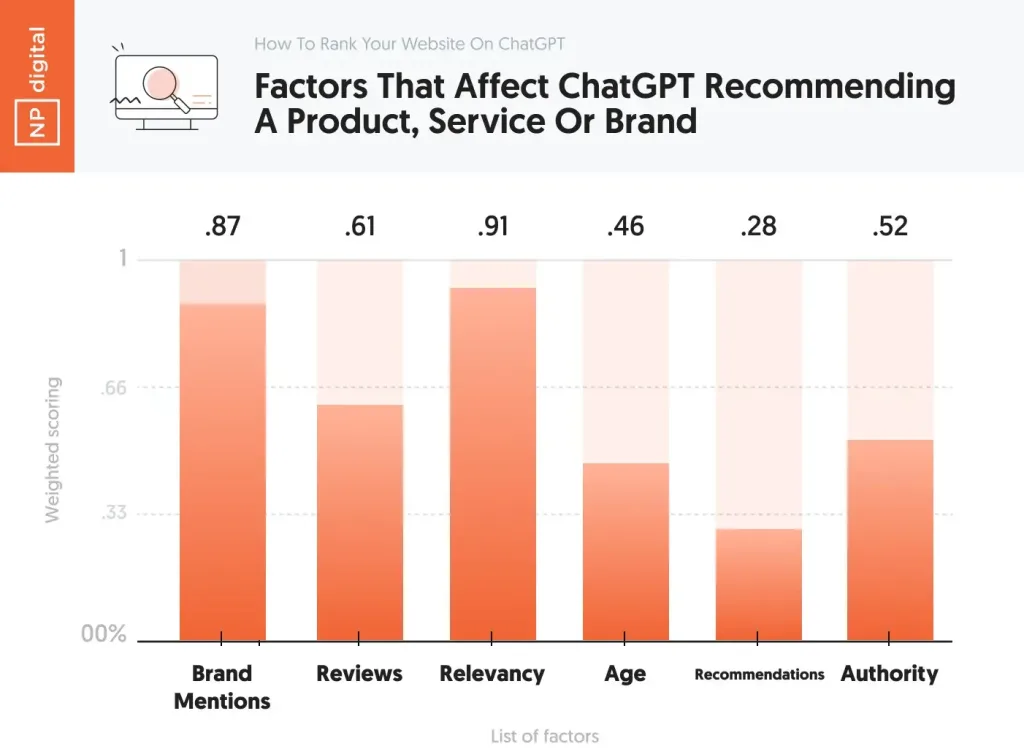
Image Source : Np Digital
Performance Metrics
The research paper suggests impression metrics to measure how well generative engines work, and offers a framework for determining the effectiveness of those GEO strategies.

Based on the metrics provided, it is clear that methods like Keyword Stuffing, which are commonly used in SEO, do not work very well.
On the other hand, using quotations, citing sources, adding statistics, optimizing fluency, using technical terms, and being authoritative are effective strategies.
Statistics and quotations significantly improve performance across all metrics considered. The top-performing methods enhance the baseline results by 41% in Position-Adjusted Word Count and by 29% in Subjective Impression.
Optimization Strategies for GEO
Studies have shown that using GEO strategies can improve the number of times your content is seen by about 30%.
This improvement highlights that it’s important to adapt your content to meet the preferences of search engines. This means using reliable sources, using statistics, and writing in a clear and easy-to-understand way.
These ideas aren’t really new. At the end of the day, it’s just about writing well. Here are some strategies that content creators should use for their content optimization.
Using relevant keywords: Include words in your content that are important for SEO. Make sure the keywords fit naturally and are easy to read so you don’t get penalized.
Citing sources: Make your content more trustworthy by mentioning where you got your information from. This shows that your claims are supported by reliable research or facts.
Adding statistics: Include numbers and data to support your arguments. This makes your content more convincing and informative.
Using quotes: Include quotes from experts or other sources that are relevant to your topic. This adds credibility and can give your audience different perspectives.
For example, the GEO research paper said:
“Interestingly, websites ranked lower in search results pages, which usually struggle to get noticed, benefit a lot more from GEO than higher-ranked websites… This led to a big 115.1% increase in visibility for websites ranked fifth in SERP.”
Making it easy to understand: Use simple language to explain complex ideas. This makes your content accessible to a wider audience and keeps them interested.
Making it flow well: Make sure your writing is smooth and doesn’t have any grammar mistakes. Well-written sentences make it easier to read and understand.
Using unique words: Include specific and original vocabulary to make your content stand out. This makes it more interesting and memorable.
Using technical terms: When appropriate, include specialized words to show your expertise in the subject. This can help you reach a more specific audience and improve your SEO for specific searches.
Creating authoritative content: Make your content more persuasive and trustworthy by using strong language and making confident claims. This builds credibility with your audience and makes your website a reliable source of information in your field.

These performance improvement stats from GEO research paper show the impact of making additions (shown in green) and deletions (shown in red).
By using GEO methods, the visibility of the source content can be greatly improved without adding much new information.
Intent-Specific Optimization
Informational Queries: When people search for knowledge or information, using citations, quotes, and statistics can really improve how visible that content is. This method meets the users’ need for trustworthy and detailed answers, making the content more credible and reliable.
Navigational Queries: If users are trying to find a specific website or page, research shows that making the content easy to read and ensuring it directly points to the desired destination can increase visibility in search results.
Transactional Queries: For searches where users want to buy a product or sign up for a service, having clear calls to action and making the content easy to understand and persuasive are important strategies for boosting visibility.
Domain-Specific Optimization Efficacy
Science and Technology: Adding technical terms and using a formal writing style worked really well in these fields. This is probably because the audience prefers clear and trustworthy information.
Arts and Humanities: In these areas, using quotes and referring to respected sources helped make the content more visible. This approach matches the audience’s interest in detailed and cultural information.
Business and Finance: Including statistics and data-based insights greatly boosted visibility, showing that the audience needs factual and useful information to make decisions.
How to Do GEO Optimization
To successfully use Generative Engine Optimization (GEO), you need to understand how generative AI works and use that knowledge to create content that appeals to both people and machines.
Research Topics Your Customers Care About:
Use keyword research tools to find out what subjects your target audience is interested in and the questions they are asking. Check how often these questions are searched on Google and see if they are likely to ask these questions to an AI tool.
Create or Improve Specific Content:
Write or enhance high-quality, relevant, and engaging content that answers the questions and topics you found. This content should be based on ideas from academic research about GEO.
Make sure to include reliable sources, quotes, and industry terms, and write in a way that shows trust and expertise.
Use Structured Data:
Add schema markup to your content to give it context and organization, which helps generative AI understand and index it better.
Focus on User Intent:
Think about why a user is searching for something and adjust your content to meet their needs. This will also help you stay ahead of changing algorithms.
Share Your Content:
Generative AI learns from more than just blog posts; it also looks at communities like Reddit and Quora. Share your content on these platforms to increase your influence on related questions.
Use Multimedia:
Make your content more interesting by adding visuals and interactive features like videos, infographics, and quizzes to engage both readers and AI search engines.
Utilize Social Media:
Post your content on social media to boost its visibility and interactions. Generative AI also considers signals from social media to rank and index content.
By using these strategies, you can effectively optimize your content for both human readers and AI-driven search engines.
GEO and SEO, What’s the Difference?
SEO mainly focuses on traditional search engines like Google, while GEO is meant for the fast-changing world of generative AI and answer engines.
These engines use complex algorithms to collect and show information in a way that makes more sense in context. This means we need different strategies to optimize for each type.
Here are some important differences between SEO and GEO:
1. Response Generation:
SEO is about getting traditional search engines to provide a list of links based on what someone searches for. GEO, on the other hand, prepares content for AI systems to quickly assemble and highlight key information, giving users fast and complete answers.
2. Content Contextualization:
SEO focuses on optimizing meta tags and including keywords to help improve search rankings. GEO makes sure that the content is clear and relevant with search queries, that allows AI algorithms to create accurate and thorough responses.
3. Information Synthesis:
SEO works to make individual pages rank better. GEO looks at how AI combines and summarizes information from different sources to give users well-rounded answers.
4. User Intent Understanding:
SEO connects keywords to what users are searching for to increase traffic. GEO uses advanced AI to better understand what users really want, providing more detailed and precise responses.
5. Algorithm Adaptation:
People who work on SEO always have to adjust to changes in search engine algorithms. GEO needs to be flexible too, adapting to the changing abilities and preferences of AI technologies.
6. Content Formatting:
SEO optimizes content for traditional search engine styles. GEO creates content that is easy for AI to read and use, including structured data and formats that work well with natural language processing.
7. Research-Driven Strategy:
SEO relies on keyword research and technical analysis to shape optimization strategies. GEO needs to analyze how AI-generated content is structured, what topics are popular, and how citation patterns change over time to improve strategies and align with how AI processes and prioritizes content.
8. Performance Tracking:
SEO tracks keyword performance, rankings, and other metrics from organic searches to refine optimization strategies. GEO monitors referral traffic from AI engines, sources cited, and response patterns to understand how AI-driven platforms prioritize and display your content, which helps guide optimization efforts.
Future Potential of GEO
As AI technology keeps advancing and more people start using generative AI in their everyday lives, the opportunities for Generative Engine Optimization (GEO) are limitless.
A recent survey by McKinsey found that 65% of organizations regularly use generative AI now, which is almost double what it was just ten months ago.
Looking Ahead to the Future of AI-Powered Search
Improving AI Abilities:
Imagine a future where AI doesn’t just answer questions, but also predicts what users might need before they even ask. With improvements in natural language processing, AI will provide more accurate and detailed answers, changing how we find information.
AI will take a more active role, giving suggestions and insights that users didn’t explicitly ask for, making the search experience better.
Voice and Visual Search Integration:
Combining GEO with voice and visual search will change how users interact with information. As AI gets better at understanding spoken questions, voice search will become more popular.
Similarly, visual search will let users find information just by taking pictures, making it easier and more intuitive to access data. To stay relevant, it’s important to optimize content for these new ways of searching.
Unified Experience:
The combination of GEO with technologies like augmented reality (AR) and voice search will enhance how users engage with digital content. Picture getting real-time help from AI, making information not only easier to get but also more interactive.
This mix of technologies will create a smooth digital experience that connects online and offline worlds.
Deep Personalization:
AI will provide highly personalized experiences, adjusting responses to fit each user’s unique likes, habits, and situations. This level of personalization will change how users engage, making every interaction feel specially designed for them.
Advancements in Multimodal AI Search:
The move towards multimodal search will enable AI to combine text, images, audio, and video in a smooth way, offering richer and more diverse search results.
This change will cater to different user preferences and learning styles, making the search process more engaging. To succeed in this new environment, content creators will need to optimize their work across different formats.
GEO isn’t just about keeping up with AI progress; it’s about shaping the future of how we interact online. Those who fully embrace the potential of generative AI and rethink their digital strategies will be at the forefront of this changing landscape.
FAQ
What are the benefits of using GEO over SEO?
- Increased visibility in AI-powered search results.
- Improved content discoverability for relevant user queries.
Can GEO and SEO be used together?
For sure! It’s actually a good idea to use both strategies to make sure your content can be seen by all kinds of search engines.
Is GEO More Important than SEO?
Not yet. SEO is still crucial, but GEO becomes increasingly important as AI search evolves.
How Can I Measure the Success of My GEO Efforts?
Track your website’s inclusion in AI search summaries and user engagement metrics within those summaries.
Will GEO Replace SEO in the Future?
It’s unlikely. SEO will likely adapt alongside GEO as search technology continues to develop.

